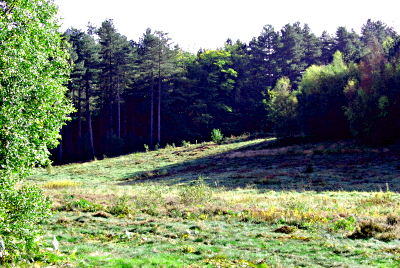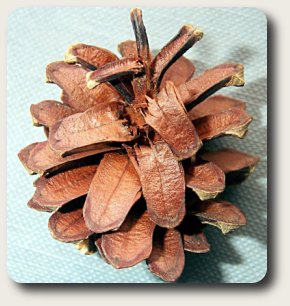
Here is a map with the main entrance to Sherwood Pines marked.
Owned by the Forestry Commission, also known as Cliptone Forest. Established in the early 20th century, a lot of the pines planted here were apparently used for pit props in the local collieries.
Probably the largest area of forest open to the public in the East Midlands, being about 1200 acres in size. It has a visitor centre, cafe and toilets as well as a cycle repair man. The main access is from off the B6030 about a kilometre east of Old Clipstone. Here there is a pay and display car park, the charge being £4 per car. Annual passes are available for £40. There is a second access road directly off the A614, here parking is free, but there are no facilities. Stagecoach East Midlands bus services 14 & 15 pass the main entrance. The timetable can be found here.
Access is more or less unrestricted for walkers. It is one of Nottinghamshire's CROW (Countryside and Rights of Way) sites. All of the marked paths are now cycle tracks with the sole exception of the white trail.
The White trail is surfaced for easy access and basically goes to the Childhood Wood (a memorial to the sufferers of Mucopolysaccharidosis) and back to the visitor centre.
 A pine forest with areas of birch, oak, sweetchestnut, horsechestnut and beech. There are open areas where the mature trees have been harvested and allowed to become heathland. Around 50% of the forest is planted with Corsican Pine, 10% with Scots Pine, somewhat under 10% is a mixture of the deciduous species mentioned previously. The rest of the area comprises felled areas, heathland, chases (tracks) and amenity areas.
A pine forest with areas of birch, oak, sweetchestnut, horsechestnut and beech. There are open areas where the mature trees have been harvested and allowed to become heathland. Around 50% of the forest is planted with Corsican Pine, 10% with Scots Pine, somewhat under 10% is a mixture of the deciduous species mentioned previously. The rest of the area comprises felled areas, heathland, chases (tracks) and amenity areas.
The north-east corner of Clipstone forest is occupied by the 400 acre Center Parcs Sherwood village. This was opened in 1987 after excavating 30 acres of lakes and the planting of 500,000 indigenous trees such as oak, silver birch and alder. The variety of bird life here is thus much greater with the ever common Coal Tit almost dominating. Redpoll, Brambling, Siskin, Common Crossbill are regularly seen. However it costs an arm and a leg to come in and view. There is a nature centre at the south-west end of the village complete with shop, interpretive centre, hide and feeding station.
The main bird species include common birds such as the Chaffinch, Robin, Wren, Coal Tit, Goldcrest, Blackcap, Garden Warbler and Blackbird. More localised ones include Common Crossbill, Tree Pipit and Nightjar.
 The Common Crossbill is supposed to feed mainly on spruce cones, but in Nottinghamshire appears to feed largely on pine. This would be because 90% of Nottinghamshire's conifers are either Scots Pine or Corsican Pine, there is very little spruce in the county. I have read also, that in Britain, Common Crossbills appear to feed on pine cones at the beginning of the year and larch in the autumn, but not very often on spruce.
The Common Crossbill is supposed to feed mainly on spruce cones, but in Nottinghamshire appears to feed largely on pine. This would be because 90% of Nottinghamshire's conifers are either Scots Pine or Corsican Pine, there is very little spruce in the county. I have read also, that in Britain, Common Crossbills appear to feed on pine cones at the beginning of the year and larch in the autumn, but not very often on spruce.
It usually feeds perched on the cone itself, but can remove small cones to take elsewhere. It gets at the seed by pushing its bill in between the cone scales and using the crossed points on the end of its bill to loosen the seed, which it then scoops up with its specially shaped tongue. If the seed cannot be reached by this method then the Crossbill can rotate its head forcing the cone scales further apart causing the type of damage as in the photograph on the right. This cone was retrieved from Cumbria and not Nottinghamshire however. Squirrels and other rodents such as mice will nibble at the cone scales to cause a different type of damage.
Crossbills can be amazingly quite when feeding in the trees but will call often when they are in flight, which is the best way to pick them up. They can be seen closely when they come to the ground to drink, often from rain puddles or sometimes from the gutters of the buildings in the visitor centre.
There can be a dozen plus Nightjars breeding in the forest, often in the more open areas.
Updated 20th December 2011Any criticisms, corrections or comments to the author Derek Huskisson

This work is licensed under a Creative Commons Attribution-Noncommercial-Share Alike 2.0 UK: England & Wales License.